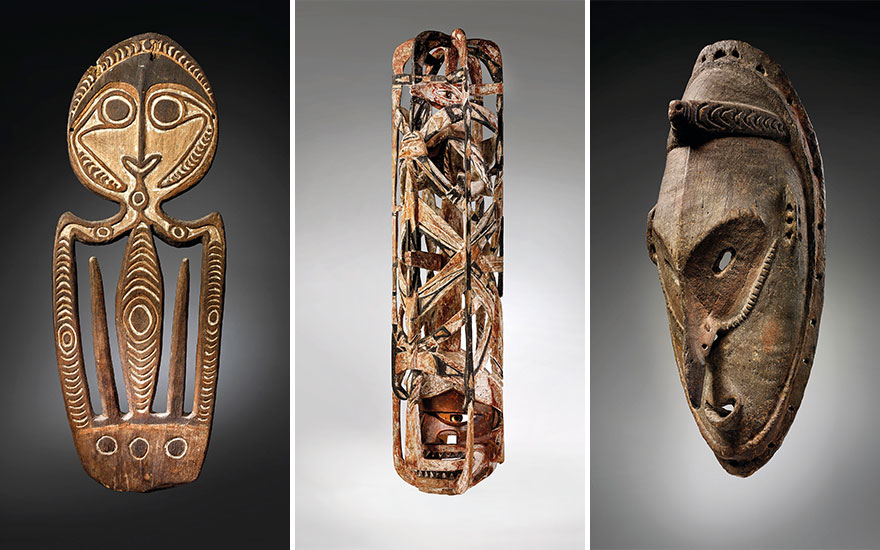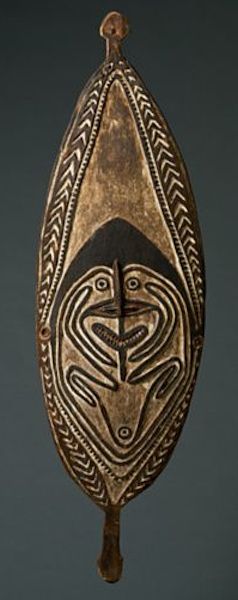Stick charts are used to help people navigate the ocean noting the ocean swell patterns island placements and so on. Most Traditional Oceanic Art Was Wiped Out By _____.

The Art Of Oceania A Guide For New Collectors Christie S
Most of the artwork created by the Abelam people of Papua New Guinea was made out of.

. A broad museological category for the traditional art of Oceania a geographic grouping for regions of Southern Hemisphere islands in the Pacific Ocean. The museum also has. The ceremonial wooden malangan from New Ireland decorative ornaments or figures intricately carved for the cycle of funeral rituals are also very popular.
Most traditional Oceanic art was wiped out by. 19½ in 495 cm. Locations include Hawaii The Easter Islands Polynesia New Zealand and Australia and these are divided into four regions.
YOU MIGHT ALSO LIKE. These are broadly representative of the vast artistic heritage of Oceania but the greatest strengths are in 20th century New Guinea art and 19th century Polynesian art. What did the Abelam.
They would in time however come to interact and together reach even more. Haitian cuisine consists of cooking traditions and practices from haitiit is a creole cu. The major theme of the festival is traditional song and dance.
What type of statuette is an African pfemba. The geographic region Oceania. The moai of Easter Island are enormous statues that watch over.
Oceanic Art Denver Art Museum. Specifically it comprises the works of the two groups of people who settled the area though during two different periods. Most traditional Oceanic art was wiped out by.
Maya conqu Subjects English. The influence of IslamD. 334 ya 1688 the dodo goes extinct.
A Japanese invasion B. The primary art form of Oceania is wooden sculpture. Art of Oceania properly encompasses the artistic traditions of the people indigenous to Australia New Zealand and the Pacific Islands.
The most important unifying element in Oceanic art remains its two-dimensionalism mainly imposed by a poorly developed technique and a few cultural factors. The art functioned for its very purpose - of celebration and identification - unlike those of the European who produced art for the arts sake. Most Oceanic art uses inorganic materials.
Oceanic art and architecture the visual art and architecture of native Oceania including media such as sculpture pottery rock art basketry masks painting and personal decoration. In the more than 80 years since the Denver Art Museum acquired its first work of Oceanic art the total collection has grown to approximately 1000 objects. The influence of Islam D.
OTHER SETS BY THIS CREATOR. The first festival was held in May of 1972 in Suva Fuji and it has been held roughly every four years since in countries around the Pacific. 395 ya 1627 the last recorded wild aurochs die out.
Most traditional Oceanic art was wiped out by. In these cultures art and architecture have often been closely connectedfor example storehouses and meetinghouses are often decorated with elaborate carvingsand so they are presented. Correct answer - Most traditional Oceanic art was wiped out by O A.
Interestingly masks are common. AA 52 53. Academic Decathlon Art History.
The 2012 Festival was hosted by the Soloman Islands from July 114 with the theme of Culture in Harmony with Nature. Most traditional Oceanic art was wiped out by O A. Most traditional Oceanic art was wiped out by.
Common types are masks small figures and carved functional objects eg. Oceanic art or Oceanian art comprises the creative works made by the native people of the Pacific Islands and Australia including areas as far apart as Hawaii and Easter Island. Offered in African Oceanic and North American Art on 29 June 2020 at Christies in Paris.
The first an Australoid people and the ancestors of modern day Melanesians and Australian. World Art 1 Final. Does Oceania represent a major region of the worl in the Olympic rings.
Which of these was a common medium for the art produced by the Edo people who formed the Benin kingdom in the 15th century AD. ArtArchitecture in Other Areas of Asia. The native peoples of the Pacific Islands from Hawaii and the Easter Islands all the way to Australia were great artisans and their works are referred to as Oceanic Art.
The most prolific regions are Melanesia and Polynesia. This primary style of two-dimensionalism is often shown in the face but also in the whole figure and recurs all the way along the migrant route followed by the Oceanians from southern Asia. The category encompasses the diverse cultural production of thousands of different peoples.
The ancestors of the people of these islands came from Southeast Asia by two different byyou groups at separate times. Traditionally most pieces of Oceanic art had some relation to the religion of the culture. For instance more than 800 different languages are spoken in Papua New Guinea alone.
Oceanic Art Culture Of Melanesia Micronesia Polynesia
.jpg?w=780)
The Art Of Oceania A Guide For New Collectors Christie S
.jpg?w=780)
The Art Of Oceania A Guide For New Collectors Christie S
Oceanic Art Culture Of Melanesia Micronesia Polynesia

Oceanic Art Sell Oceanic Art Antique Oceanic Art Old Oceanic Artifact
.jpg?w=780)
.jpg?w=380)
0 komentar
Posting Komentar